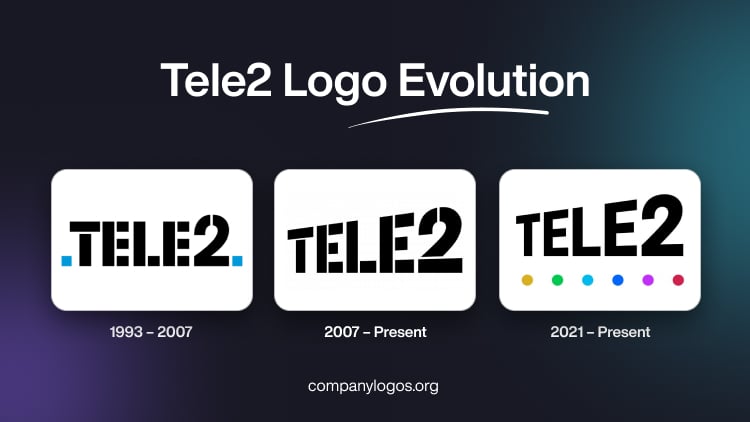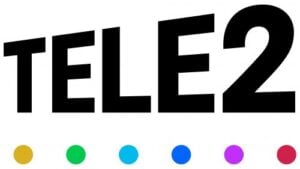
Tele2 is a Swedish mobile services provider that was founded in 1993 in Stockholm. The company has become an important telecommunications provider across Europe and Russia, which is known for its disruptive spirit and customer-centric approach. Over the years, the Tele2 logo has evolved to reflect the company’s growth, mergers, and changing brand identity. The article takes a detailed look at the history and evolution of the Tele2 logo.
The Genesis of the Tele2 Logo (1993 – 2007)
When Tele2 was established in 1993, its initial branding focused on simplicity and clarity. The original logo featured a geometric wordmark in black with two square dots in blue on either side. The wordmark was written using an extra-bold stencil font with the digit “2” displayed in an enlarged format.

(2007 – Present)
In 2007, Tele2 introduced a new logo that marked a significant shift in its visual identity. The updated logo featured a bold, uppercase “TELE2” wordmark with a distinctive design element. The digit “2” appeared to leap forward and take a prominent and dynamic position. This design choice conveyed a sense of movement, progress, and rebellion. It reflected Tele2’s role as a challenger in the telecommunications market.
The black-and-white colour scheme added to the logo’s assertive and modern look. It helped Tele2 stand out in a competitive industry. The bold but angled logo shows a sense of motion with the digit “2” appearing to leap forward, while the rest of the letters fade into the background. The black colour of the palette symbolises stability and confidence, while white symbolises simplicity and purity.

(2021 – Present)
The 2021 redesigned logo made a few subtle changes to the previous iteration. The letters of the wordmark were written using a bold, geometric, solid font. They were turned a little to create a sense of motion. Beneath the wordmark appeared six solid dots in a rainbow-esque colour scheme – from calm orange to crimson red.

The Elements of the Tele2 Logo
Font
The wordmark that forms the visual identity of Tele2 is written in a stencil sans-serif typeface. It is similar to fonts such as Stencilla Regular and Basic Stencil JNL.
Colour
The logotype uses a monochrome colour palette, which aligns with the square shapes of the letters forming the wordmark. Besides, the black and white combination makes the visual identity bright and recognisable across platforms.
The History of Tele2
Tele2 is a renowned telecommunications company in the Nordics and Baltics, which is recognised for its innovative approach, disruptive market presence, and strong commitment to sustainability. The company’s roots date back to 1991 with Swipnet, Sweden’s first commercial internet provider. In fact, it was Swipnet that broke the state monopoly and made the internet accessible to the Swedish public. Tele2 was officially founded in 1993 by Jan Stenbeck, and it quickly established itself in Sweden. It did so by offering affordable, transparent, and customer-focused telecom services and challenged the dominance of established players.
In 1996, Tele2 expanded into mobile telephony and, by 1999, began its international journey by entering the Russian market. The company’s IPO in 2000 on the Stockholm Stock Exchange provided the capital needed for further growth. In 2003, the acquisition of Comviq strengthened its mobile sector presence. By 2006, Tele2 streamlined operations by divesting its fixed-line business to focus on mobile services.
The decade thereafter saw Tele2 embracing technological innovation and strategic mergers. In 2010, it introduced IoT solutions, and by 2011, it launched LTE broadband to meet growing data demands. The 2016 merger with TDC Sweden boosted its Nordic market share, and the 2018 merger with Com Hem created a comprehensive telecom and media company. This led to the integration of broadband and TV services. Tele2’s European footprint expanded further in 2019 through the merger of its Dutch subsidiary with T-Mobile NL. By 2020, Tele2 had sharpened its focus on IoT and digital innovation.
In recent years, Tele2 has emerged as a leader in sustainability. It has been named the Climate Leader in Europe by the Financial Times in 2023 and Sweden’s most sustainable company by Time Magazine in 2024. It stands out as the only telecom provider in the Nordics and Baltics with an approved net zero science-based target. In 2024, the acquisition of Kinnevik’s stake in Tele2 by Iliad, a major European telecom group, marked a new chapter in the company’s ownership and strategic direction.
Over the years, Tele2 has played a crucial role in democratising internet access, challenging monopolies, and setting industry standards for affordability, transparency, and innovation. Today, it continues to serve millions across the Nordics, Baltics, and Europe. It continues to maintain its reputation as a forward-thinking, customer-centric, and environmentally responsible telecom leader.
Interesting Facts About Tele2
- Tele2 was founded in 1993 in Sweden by AB Kinnevik and is headquartered in Kista Science City, Stockholm.
- It is a major mobile network operator in Sweden, Estonia, Latvia, and Lithuania. It offers a broad range of services, including mobile and fixed connectivity, telephony, data network services, TV, streaming, and Internet of Things solutions.
- Tele2 was a pioneer in building the world’s first 3G network in 2000 and launched Sweden’s first public 5G network in 2021.
- The company has a strong challenger spirit rooted in its founder Jan Stenbeck’s mission. This is about breaking telecom monopolies and making services more accessible and affordable.
- Tele2 has been recognised as Sweden’s greenest and most energy-efficient mobile network operator since 2019 and was the first climate-neutral telecom in the Nordics and Baltics in 2020.
- In 2023, Tele2 was named the #1 Climate Leader in Europe by the Financial Times. It ranked first among 500 European companies for climate action.
- Tele2 has set ambitious sustainability targets. These include achieving 100% circularity for network equipment by 2025, collecting 100,000 phones for recycling or reuse by 2026, and reducing greenhouse gas emissions by 96% (scope 1 and 2) since 2019.
- The company blocked over 7 million attempts to access child sexual abuse material in 2024. It was a 40% increase compared to the previous year and demonstrated its commitment to online safety.
- Tele2 has been recognised globally for gender equality. It is ranked 58th worldwide by Equileap and among the top 100 companies for gender balance in leadership.
- Tele2’s Dutch operations were launched in 1997. These were merged with T-Mobile Netherlands in 2019, wherein Tele2 retained a 25% stake in the combined company until the brand was fully rebranded as Odido in 2023.
- The company reported revenues of approximately 29 billion SEK (€2.5 billion) in 2023 and employs over 4,300 people.
- In 2024, a major European telecom group, Iliad, acquired Kinnevik’s stake in Tele2 in 2024.
Finally
The Tele2 logo and its various iterations show the journey of the company from a disruptive newcomer to a leading European telecom provider. Each phase of logo development reflects strategic shifts – whether it’s the bold leap in 2007 or the premium, unified identity after merging with Com Hem. Today, Tele2’s visual brand stands as a testament to its commitment to innovation, simplicity, and customer focus.